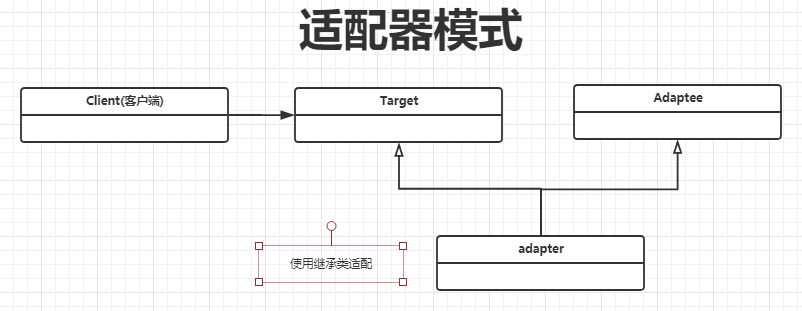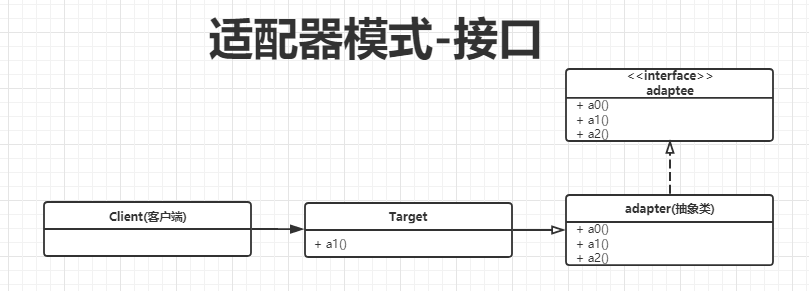一、是什么
1. 定义:让原来不兼容的两个接口协同工作
2. 分类: 类适配器、对象适配器、接口适配器
3. 角色
- 目标接口:Target,该角色把其他类转换为我们期望的接口
- 被适配者: Adaptee 原有的接口,也是希望被改变的接口
- 适配器: Adapter, 将被适配者和目标接口组合到一起的类
4. 类图
对象适配器,使用组合

类适配器,在java中实现不了,需要多重继承才能实现,类图是这个样子的,当然如果变通一下,Target是接口就可以了

接口适配器 抽象方法

接口适配器的使用场景: 原有接口有很多方法,而我们只需要其中一部分,这是看可以用抽象类来实现该接口,不需要的方法只需要写个空方法(默认实现)就好了,接口目标类去实现自己需要的接口
适用的场景是不想实现原有类的所有方法
二、示例
- 背景:买了一个进口笔记本电脑
- 冲突:笔记本电脑需要的三项电源,和只提供的二项电源冲突
- 解决方案:设置一个适配器二项充电口转化为三项充电口
2.1.1 Adaptee 原有的类 提供二项电
/** * 插头 二项供电 Adaptee */ public class TwoPower { public void powerByTwo() { System.out.println("提供二项供电"); } }
2.1.2 Target 目标类 能输出三项供电
/** * 插头提供三项供电 (target) */ public interface ThreePower { /** * 三项供电 */ void powerByThree(); }
2.1.3 对象适配器,转换类 Adapter
/** * 二项转三项的适配器 组合的方式 对象适配器 */ public class TwoToThreeAdapter implements ThreePower{ /** * 使用委托来完成适配 */ private TwoPower twoPower; public TwoToThreeAdapter(TwoPower twoPower) { this.twoPower = twoPower; } @Override public void powerByThree() { System.out.println("借助组合适配器转化二项电"); twoPower.powerByTwo(); } }
2.1.4 类适配器 转换类 Adapter
/** * 二项转三项的适配器 继承的方式 类 */ public class TwoToThreeAdapter2 extends TwoPower implements ThreePower { @Override public void powerByThree() { System.out.println("借助继承适配器转化二项电"); this.powerByTwo(); } }
测试
/** * 笔记本电脑 这是使用组合模式的-适配器模式 */ public class NoteBook { /** * 期望的三项供电接口 */ private ThreePower threePower; public NoteBook(ThreePower threePower) { this.threePower = threePower; } public static void main(String[] args) { // ============================ 继承方式的适配器使用 类适配器 ===================================== ThreePower threePower1 = new TwoToThreeAdapter2(); NoteBook noteBook1 = new NoteBook(threePower1); noteBook1.recharge(); noteBook1.work(); // ============================ 组合方式的适配器使用 对象适配器 ===================================== // 现在只有二项供电 TwoPower twoPower = new TwoPower(); ThreePower threePower = new TwoToThreeAdapter(twoPower); NoteBook noteBook = new NoteBook(threePower); // 1. 充电 noteBook.recharge(); // 2. 工作 noteBook.work(); } public void work() { System.out.println("笔记本电脑开始工作!"); } public void recharge() { // 使用三项充电 threePower.powerByThree(); } }
控制台显示:
提供二项供电
借助继承适配器转化二项电
笔记本电脑开始工作!
提供二项供电
借助组合适配器转化二项电
笔记本电脑开始工作!
三、总结
适配器好处
- 重用
- 复用的现存的类, 解决了现存类和复用环境要不一致的问题
- 低耦合
- 无需修改原有代码(遵循开闭原则)
这里说些缺点吧,过多的使用适配器,的确会让程序看起来很难懂,我的理解是,在适配别人接口和其他API接口时,适配器的用处就来了
